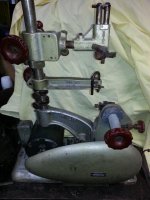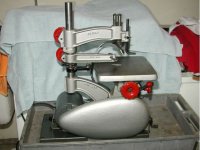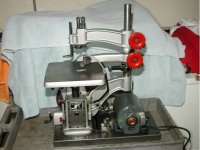crrmeyer
Stainless
- Joined
- Nov 10, 2006
- Location
- Southern California
Well I went off to look at a vise from a Craigslist ad. In the garage across from a Bridgeport mill was the dirty clump of a machine. I knew from the belt cover that it was a All American Die Filer in a few pieces. Unfortunately the owner was tired of tripping over the table and threw it away a couple of month before. Things that make you want to cry. But the price was reasonable so I picked it up. I figured someone would need the parts.
After I got it home I detailed it with a toothbrush and a shop vacuum. What emerged was a reasonably nice machine as shown in the first three photos. A few rusty bits and in need of oil, but it did run. The rubber boot has a small tear. And it is missing the blower hose. But otherwise it is all there.
Now this puts me in a bit of a dilemma - I already have a pristine All American Die Filer as shown in the forth and fifth photos. Where as last night I was thinking of this as a parts donor, today I am wondering what are my options for table replacement.
I could:
1) try and find a factory table (very doubtful)
2) see if there is a small scroll saw table top that I could adapt
3) Find a blanchard ground piece of 10" x 10" x 3/8" or so thick steel and just make one.
4) Cast a new one (I have a model)
I am leaning towards option 3 as this would be a user machine. Any thoughts?
Before going farther I should probably go into the guts and see what condition they are it.
The pristine one has a serial number about 200 greater that the parts one I picked up. Interestingly the spring loaded top guide of the later one dies not have all the adjustments of the earlier one. I can see having very minor adjustments make the file go straight, but this one has 1"+ of travel and large angular rotation. This makes me wonder if I am missing something?
What is a little odd on the new filer is that the post that holds the guides is about 36" long. Why - I have no idea. I should probably cut it down to a more standard length.
After I got it home I detailed it with a toothbrush and a shop vacuum. What emerged was a reasonably nice machine as shown in the first three photos. A few rusty bits and in need of oil, but it did run. The rubber boot has a small tear. And it is missing the blower hose. But otherwise it is all there.
Now this puts me in a bit of a dilemma - I already have a pristine All American Die Filer as shown in the forth and fifth photos. Where as last night I was thinking of this as a parts donor, today I am wondering what are my options for table replacement.
I could:
1) try and find a factory table (very doubtful)
2) see if there is a small scroll saw table top that I could adapt
3) Find a blanchard ground piece of 10" x 10" x 3/8" or so thick steel and just make one.
4) Cast a new one (I have a model)
I am leaning towards option 3 as this would be a user machine. Any thoughts?
Before going farther I should probably go into the guts and see what condition they are it.
The pristine one has a serial number about 200 greater that the parts one I picked up. Interestingly the spring loaded top guide of the later one dies not have all the adjustments of the earlier one. I can see having very minor adjustments make the file go straight, but this one has 1"+ of travel and large angular rotation. This makes me wonder if I am missing something?
What is a little odd on the new filer is that the post that holds the guides is about 36" long. Why - I have no idea. I should probably cut it down to a more standard length.

















